Related Research Articles

A beehive is an enclosed structure in which some honey bee species of the subgenus Apis live and raise their young. Though the word beehive is used to describe the nest of any bee colony, scientific and professional literature distinguishes nest from hive. Nest is used to discuss colonies that house themselves in natural or artificial cavities or are hanging and exposed. The term hive is used to describe an artificial/man-made structure to house a honey bee nest. Several species of Apis live in colonies. But for honey production, the western honey bee and the eastern honey bee are the main species kept in hives.

A beekeeper is a person who keeps honey bees.

Beekeeping is the maintenance of bee colonies, commonly in man-made beehives. Honey bees in the genus Apis are the most commonly kept species but other honey producing bees such as Melipona stingless bees are also kept. Beekeepers keep bees to collect honey and other products of the hive: beeswax, propolis, bee pollen, and royal jelly. Pollination of crops, raising queens, and production of package bees for sale are other sources of beekeeping income. Bee hives are kept in an apiary or "bee yard".
An apiary is a location where beehives of honey bees are kept. Apiaries come in many sizes and can be rural or urban depending on the honey production operation. Furthermore, an apiary may refer to a hobbyist's hives or those used for commercial or educational usage. It can also be a wall-less, roofed structure, similar to a gazebo which houses hives, or an enclosed structure with an opening that directs the flight path of the bees.
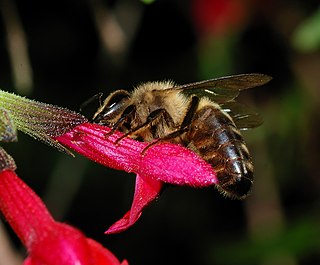
The European dark bee is a subspecies of the western honey bee, evolving in central Asia, with a proposed origin of the Tien Shan Mountains and later migrating into eastern and then northern Europe after the last ice age from 9,000BC onwards. Its original range included the southern Urals in Russia and stretched through northern Europe and down to the Pyrenees. They are one of the two members of the 'M' lineage of Apis mellifera, the other being in western China. Traditionally they were called the Black German Bee, although they are now considered endangered in Germany. However today they are more likely to be called after the geographic / political region in which they live such as the British Black Bee, the Native Irish Honey Bee, the Cornish Black Bee and the Nordic Brown Bee, even though they are all the same subspecies, with the word “native” often inserted by local beekeepers, even in places where the bee is an introduced foreign species. It was domesticated in Europe and hives were brought to North America in the colonial era in 1622 where they were referred to as the English Fly by the Native Americans.
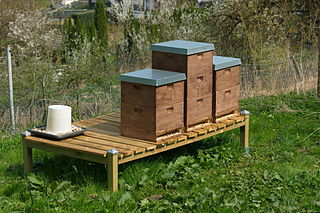
In modern American beekeeping, a Langstroth hive is any vertically modular beehive that has the key features of vertically hung frames, a bottom board with entrance for the bees, boxes containing frames for brood and honey and an inner cover and top cap to provide weather protection. In a Langstroth hive, the bees build honeycomb into frames, which can be moved with ease. The frames are designed to prevent bees from attaching honeycombs where they would either connect adjacent frames, or connect frames to the walls of the hive. The movable frames allow the beekeeper to manage the bees in a way which was formerly impossible.
Ormond R. Aebi was an American beekeeper who was reported to have set the world's record for honey obtained from a single hive in one year, 1974, when 404 pounds of honey were harvested, breaking an unofficial 80-year-old record of 303 pounds held by A. I. Root. Together with his father Harry, the Aebi's wrote two books on beekeeping: The Art and Adventure of Beekeeping (1975) and Mastering the Art of Beekeeping (1979).

Moses Quinby was an American beekeeper from the State of New York. He is remembered as the father of practical beekeeping and the father of commercial beekeeping in America. He is best known as the inventor of the bee smoker with bellows. He was the author of numerous articles and several books on beekeeping.
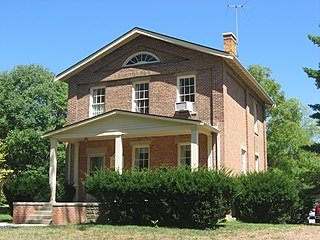
Langstroth Cottage is a historic building on the Western College campus of Miami University in Oxford, Ohio. It was designated a National Historic Landmark on June 22, 1976. The cottage, built in 1856, is now the home for the Oxford office of the Butler County Regional Transit Authority. It was purchased for Beekeeper L. L. Langstroth in 1859, and he lived there for the next 28 years, conducting research and breeding honey bees.

Stephen Taber III. was an American apiologist, noted authority and author in the field of artificial insemination of queen bees for the purpose of developing disease resistant and gentle bee colonies.

Commercial Beekeeping in the United States dates back to the 1860s.

Beekeeping in New Zealand is reported to have commenced in 1839 with the importing of two skep hives by Mary Bumby, a missionary. It has since become an established industry as well a hobby activity.
Beekeeping is first recorded in Ireland in the seventh century. It has seen a surge in popularity in modern times, with the membership of beekeeping associations exceeding 4,500. The median average number of hives per beekeeper is three hives, while the average honey output per hive is 11.4 kg. The growth in the practice has occurred despite increased pressures on bees and beekeepers due to parasites, diseases and habitat loss.

The Apiary Laboratory, more often referred to as the Apiary, is a research laboratory at the University of Massachusetts Amherst. Originally built for the study of honey bees and apiculture, today it is primarily used to study native pollinator species and the chemicals and pathogens impacting their populations. This academic building is unique in that it is credited as being the first in the United States to be erected exclusively for the teaching of beekeeping.
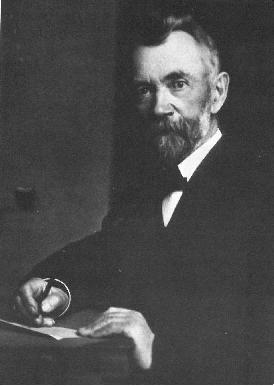
Robert August Holekamp was a businessman and apiarist from the St. Louis suburb of Webster Groves, Missouri. Holekamp was significant in the development of Webster Groves, and had state and national influence in the field of beekeeping.
Lee Henderson Watkins (1908–1972) was born in 1908. He was an amateur apiculturist and anthropologist, member of the AAA, president of the Alameda County Beekeepers' Association (ACBA) from 1949–1951, and eventually emeritus apiarist of the University of California, Davis.
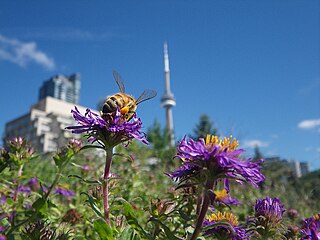
Urban beekeeping is the practice of keeping bee colonies (hives) in towns and cities. It is also referred to as hobby beekeeping or backyard beekeeping. Bees from city apiaries are said to be "healthier and more productive than their country cousins". As pollinators, bees also provide environmental and economic benefits to cities.

A Honey Queen Program is a local, state, or national program which annually selects young women to become the spokespeople for the honey and beekeeping industries in the area, state, or region. The national program, the American Honey Queen Program, is facilitated through the sponsorship of the American Beekeeping Federation and involves a lengthy competition, the winners of which travel around the United States and beyond promoting the honey and beekeeping industries and educating the public on the importance of honey bees, beekeeping, and honey.

Franz Hruschka, Franz von Hruschka, Francesco De Hruschka, František Hruška was an Austrian/Italian of Czech origin officer and beekeeper known as the inventor of the honey extractor, an invention he presented in 1865 at the Brno Beekeeper Conference.
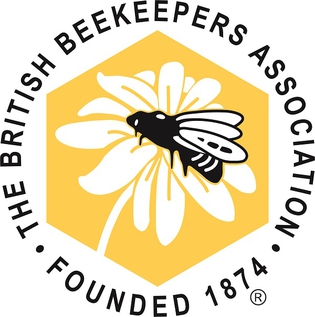
The British Beekeepers Association (BBKA) is a charitable organisation registered in England and Wales that was founded in 1874. It is made up of 75 associations in England & Wales plus one in Northern Ireland, Isle of Man and Jersey. At end of 2018 there were 26,555 members. Its patrons include the Worshipful Company of Wax Chandlers and Jimmy Doherty.
References
- ↑ Educators of Michigan "Google Books" Wilton-Smith, 1894
- ↑ Death Record "Ancestry.com"
- ↑ Annual archaeological report, Volumes 13-16 "Google eBook", L.K. Cameron, 1901
- ↑ Ohio archæological and historical quarterly, Volume 1, "Google eBook", Published for the Ohio State Archaeological and Historical Society by A.H. Smythe, 1888
- ↑ Educators of Michigan "Google eBook" Wilton-Smith, 1894
- ↑ Publications of the Buffalo Historical Society, Volume 9 "Google eBook"
- ↑ Publications of the Buffalo Historical Society, Volume 11 "Google eBook"
- ↑ The Overland Monthly "Google eBook"; Samuel Carson, 1917
- ↑ Hiawatha "Amazon Bookstore"
- ↑ The Joseph Keppler Iroquois Papers "Cornell University Library" Archived June 17, 2012, at the Wayback Machine
- 1 2 Marple, Richard "Brief Historical Notes Chronologically Arranged on the Alameda Beekeepers' Association," Archived July 14, 2014, at the Wayback Machine 1988, May 10.
- 1 2 "History of American Beekeeping" 1938
- ↑ "Bee Commercial Services" [ permanent dead link ] 21 April 2012
- ↑ "American Bee Journal" 1921, February
- ↑ "Gleanings In Bee Culture, April, 1921"
- ↑ "Honey Producers' Co-Operator" 1921, March–April, Vol.2 No.3
- ↑ "The Western Honey Bee" March, 1922
- ↑ "Gleanings in Bee Culture' 1922, March
- ↑ "Bulletin - California Agricultural Experiment Station, Issues 536-555" California Agricultural Experiment Station, 1932
- ↑ "The Western Honey Bee" 1922, July
- ↑ "The Beekeepers' Review" 1922, November
- ↑ "Bee World" International Bee Research Association., 1942
- Watkins, Lee H., Historical Notes on Our State Association. The California Bee Times 9 (4)?:2, Oct. 1968
- Pellett, Frank Chapman, History of American Beekeeping. Ames, IA Collegiate Press, 1938, p. 141.